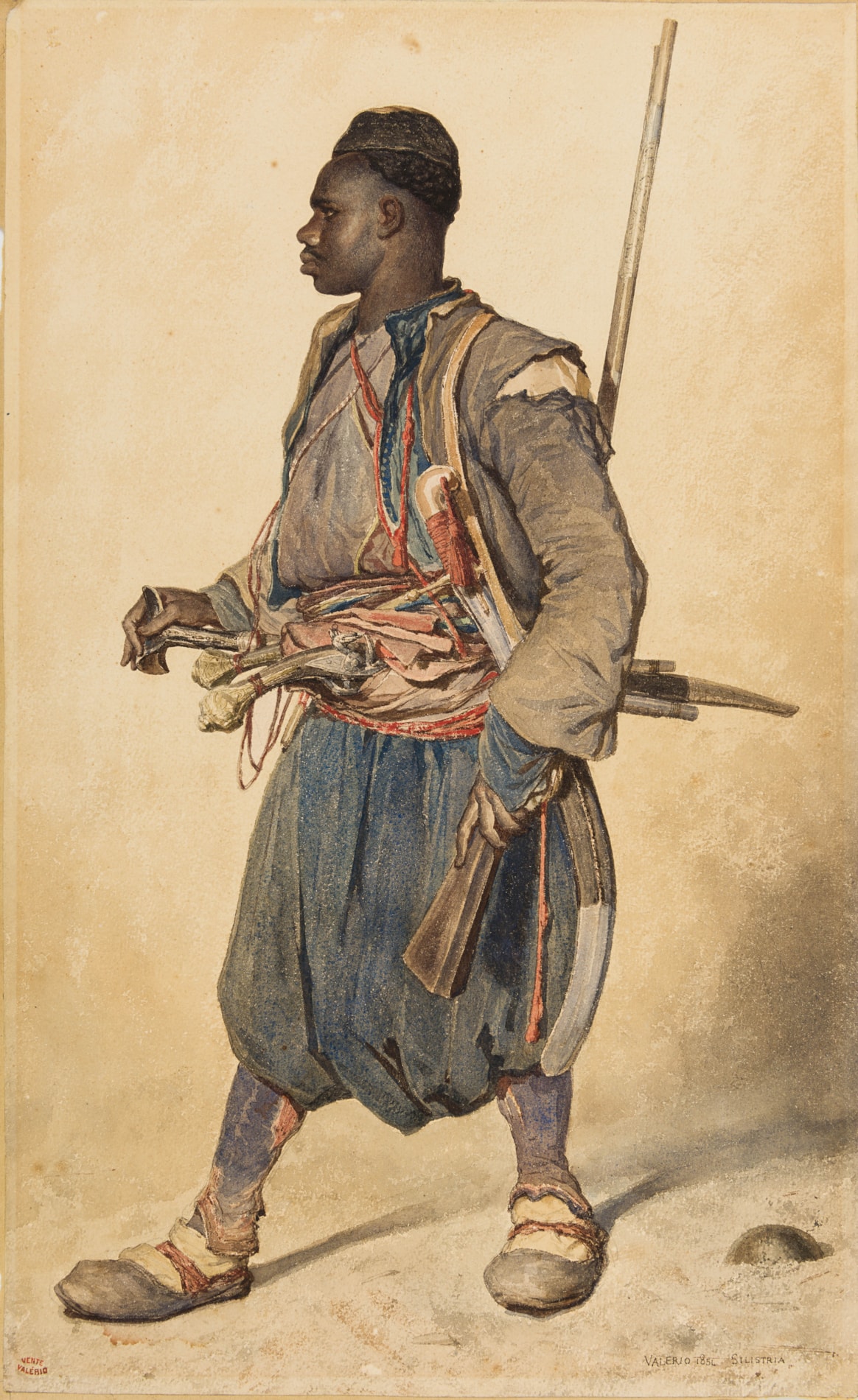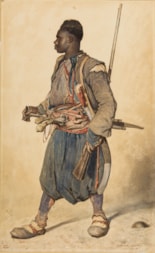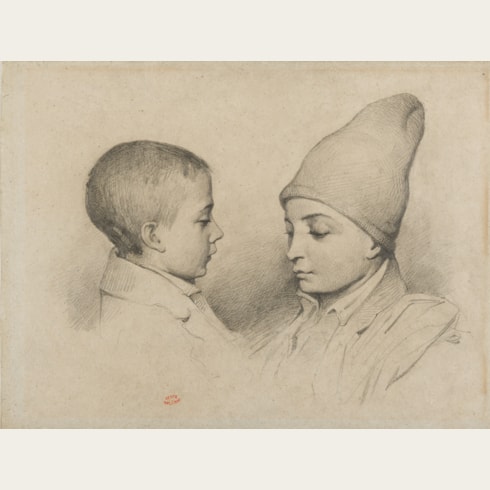Théodore VALERIO
(Herserange 1819 - Vichy 1879)
A Bashi-Bazouk from Upper Egypt
Sold
Watercolour, pen and brown ink and brown wash, over traces of a pencil underdrawing, on light brown paper.
Signed and dated VALERIO 1854 SILISTRIA at the lower right.
Stamped with the Valerio vente stamp (Lugt 2476) at the lower left.
Inscribed and numbered Le negre [?] / 02886500 on a label pasted onto the old backing board.
453 x 277 mm. (17 7/8 x 10 7/8 in.) [sheet]
Signed and dated VALERIO 1854 SILISTRIA at the lower right.
Stamped with the Valerio vente stamp (Lugt 2476) at the lower left.
Inscribed and numbered Le negre [?] / 02886500 on a label pasted onto the old backing board.
453 x 277 mm. (17 7/8 x 10 7/8 in.) [sheet]
This drawing of a bashi-bazouk was drawn in 1854 at an Ottoman military camp in Silistria, a town on the banks of the Danube in what is today northeastern Bulgaria. A bashi-bazouk was an irregular soldier of the Ottoman army. Although usually of Albanian, Kurdish or Circassian origins, they could be of any ethnicity. During the early 1850s Théodore Valério was engaged on a series of studies of the various peoples of the Austro-Hungarian and Ottoman empires. In 1854, the date of the present sheet, Silistria found itself on the front lines during the Crimean War; indeed, the Ottoman-ruled town was besieged by Russian forces between April and June of that year.
This watercolour is closely related to, and may be a study for, an etching and drypoint, of somewhat smaller dimensions, entitled Bachi-Bozoucq de la haute Egypte (camp de Silistrie). The print was reproduced as Plate 2 in Valério’s album Les Populations des provinces danubiennes en 1854, published in Paris around 1855.
This watercolour is closely related to, and may be a study for, an etching and drypoint, of somewhat smaller dimensions, entitled Bachi-Bozoucq de la haute Egypte (camp de Silistrie). The print was reproduced as Plate 2 in Valério’s album Les Populations des provinces danubiennes en 1854, published in Paris around 1855.
Of Italian origins, Théodore Valério was born in the Moselle region of eastern France, not far from the border with Luxembourg, and entered the Parisian studio of Nicolas-Toussaint Charlet in 1834. The two artists soon became friends, and in 1836 travelled together on a sketching tour of Germany, Switzerland and Italy. Valério made his public debut in 1838, at the age of nineteen, at the Salon des Artistes Vivants. He continued to exhibit at the Salons until his death, winning a third-class medal in the category of engraving in 1859. A painter, engraver and draughtsman, he produced landscapes, genre scenes and military subjects. He was an inveterate traveller, and in the 1840s and 1850s made extensive tours of Italy, Switzerland, Germany, Austria, Hungary and Romania, as well as the Balkans and Turkey. During the Crimean War Valério was attached to the Ottoman army commanded by Omar Pasha, and produced drawings and watercolours of the conflict, notably the siege of Sebastopol, as well as of the multitude of soldiers and civilians from across the Ottoman Empire who made up the Sultan’s army.
Valério made numerous drawings and studies of the exotic costumes and features of the peoples that he saw on his travels, particularly in the countries of Eastern Europe and the Austro-Hungarian empire. He was far, however, from being a pampered tourist. Travelling either on foot or horseback, and venturing far from major cities, the artist lived and dined among the rural peasantry and nomadic peoples of the region, of which he produced many insightful and sympathetic drawn portraits. These documentary works were praised by the critic Théophile Gautier, who saw Valério as an artist-ethnographer, and a large group of drawings and watercolours by the artist – mainly portraits executed on trips to Hungary and the Balkans between 1851 and 1854 - were exhibited at the Exposition Universelle in Paris in 1855, to considerable acclaim, and were purchased by the State; these are today in the collection of the Ecole des Beaux-Arts in Paris. Many of Valério’s drawings and genre scenes were also reproduced in the form of albums of lithographs or etchings, notably Les Populations des provinces danubiennes en 1854, published in Paris around 1855. Valério also published an account of his travels, entitled ‘Essais ethnographiques sur les populations hongroises’, in the magazine L’Artiste in 1858. The artist spent much of his later years in Brittany, which he had first visited in 1843, and also spent some time in England before his death in 1879. The following year, a sale of some of the contents of his studio, including sixty paintings and numerous drawings, was held in Paris.
Valério made numerous drawings and studies of the exotic costumes and features of the peoples that he saw on his travels, particularly in the countries of Eastern Europe and the Austro-Hungarian empire. He was far, however, from being a pampered tourist. Travelling either on foot or horseback, and venturing far from major cities, the artist lived and dined among the rural peasantry and nomadic peoples of the region, of which he produced many insightful and sympathetic drawn portraits. These documentary works were praised by the critic Théophile Gautier, who saw Valério as an artist-ethnographer, and a large group of drawings and watercolours by the artist – mainly portraits executed on trips to Hungary and the Balkans between 1851 and 1854 - were exhibited at the Exposition Universelle in Paris in 1855, to considerable acclaim, and were purchased by the State; these are today in the collection of the Ecole des Beaux-Arts in Paris. Many of Valério’s drawings and genre scenes were also reproduced in the form of albums of lithographs or etchings, notably Les Populations des provinces danubiennes en 1854, published in Paris around 1855. Valério also published an account of his travels, entitled ‘Essais ethnographiques sur les populations hongroises’, in the magazine L’Artiste in 1858. The artist spent much of his later years in Brittany, which he had first visited in 1843, and also spent some time in England before his death in 1879. The following year, a sale of some of the contents of his studio, including sixty paintings and numerous drawings, was held in Paris.
Provenance
Among the contents of the artist’s studio at the time of his death
The Valério studio sale, Paris, Hôtel Drouot, 12-14 February 1880 (lot number unidentified, possibly lot 74: ‘Soldat nègre de la Haute-Egypte (Siège de Silistrie)’).
The Valério studio sale, Paris, Hôtel Drouot, 12-14 February 1880 (lot number unidentified, possibly lot 74: ‘Soldat nègre de la Haute-Egypte (Siège de Silistrie)’).






